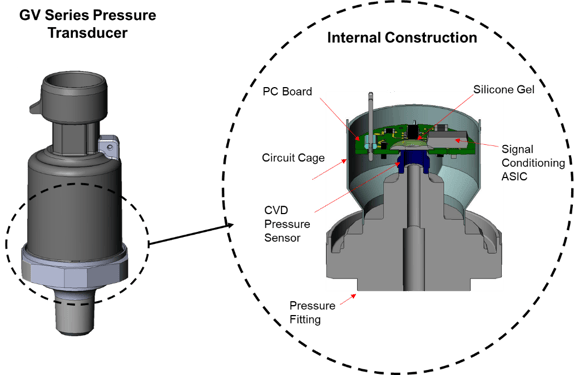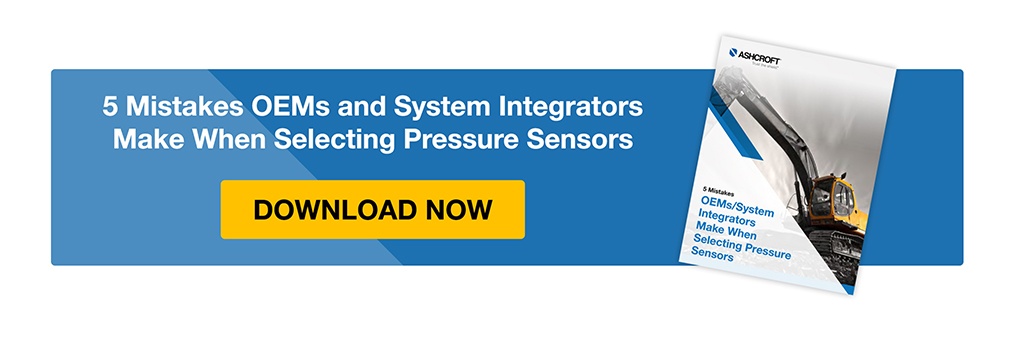Subscribe now and get the latest blog posts delivered straight to your inbox.
How to Protect and Optimize Pressure Instruments in Mobile Hydraulics

This article was originally published on June 1, 2021, and updated on December 9, 2024.
Hydraulic machinery outperforms nearly all other mechanical power transmission methods in extreme environments. Excavators, tree harvesters, mining trucks, tow trucks, and other hydraulic vehicles handle the toughest tasks on uneven terrains, carrying heavy loads that exert immense forces on hydraulic systems.
These operations can cause severe shocks and vibrations, along with significant changes in temperature, dust, and moisture. Additionally, pressure spikes or impulses within hydraulic systems can pose a major challenge to the reliability of internal components like pressure instruments. So, how can you enhance the performance of your mobile hydraulics to withstand these hazards?
Pressure control and monitoring devices are essential for managing hydraulic systems and enhancing power, flexibility, speed, and safety. They regulate and monitor hydraulic fluid pressure levels to provide the necessary force to overcome resistance. They also detect unsafe conditions, trigger alarms, or automatically shut down hydraulic pumps to prevent overpressure situations.
In my extensive experience in this industry, I have learned how to effectively apply pressure transducers in mobile hydraulics control systems. This article will guide you through the challenges of pressure control and measurement, including shock, vibration, pressure spikes, pulsation, and environmental factors, and show you how to maintain your mobile hydraulic machines in top condition.
Understanding the challenges in hydraulic applications.
OEM hydraulic systems play a pivotal role in operating heavy machinery. However, the harsh and demanding conditions this equipment endures will have a significant impact on the instruments that are designed to ensure the system's performance and durability. Here are the most common challenges pressure sensors encounter in hydraulic applications:
Shock in OEM hydraulic systems
Hydraulic shock occurs when there is a sudden change in fluid velocity, which is often caused by an external impact. When this happens your pressure instrument must withstand the physical impact, the sudden change in fluid velocity and the sudden stop of the system.
Many instruments are also impacted by short frequency/high amplitude pulses. Unlike air, hydraulic fluid is non-compressible and pressure spikes in the system can increase four to five times over the normal operating pressure. That affects the performance and lifespan of pressure instruments if they are not strategically designed and protected.
The impact of vibration
Vibration in hydraulic systems is caused by mechanical oscillations or noise from motors, pumps, actuators, valves, hydraulic lines and other components. These vibrations can create flow ripples, leading to harmonic pressure waves that impact the system's components. High frequency/low amplitude pulses from vibration can degrade the performance and lifespan of pressure instruments if not strategically designed and protected.
Pressure spikes
Pressure spikes, or impulses, occur when fluid flow rates change rapidly, similar to a water hammer effect. These spikes can generate high-magnitude pressure waves that exceed normal operating pressures in microseconds. Without proper protection and strategic placement, pressure instruments can be damaged by these sudden changes, compromising the system's reliability.
Pressure transducers in mobile hydraulics.
Pressure transducers for mobile hydraulic applications can be damaged under shock and vibration operating conditions if not appropriately designed. Having compact sensing elements, shorter wire bonds, a coplanar design, and a small footprint to withstand shock and vibration are all important features that can help prevent damage to these instruments.
To meet the above requirements, Ashcroft developed our CVD thin film pressure sensor with high stability, accuracy and wide operating temperature ranges. In addition, we use a silicone gel that absorbs shock and vibration to protect delicate wire bonds, which connect the sensor element to the electronics. Figure 1 shows the cross-section of the Ashcroft® GV Pressure Transducer enhanced design for vibration and shock application.
 Figure 1- Ashcroft GV Pressure Transducer with enhanced Vibration and Shock Protection
Figure 1- Ashcroft GV Pressure Transducer with enhanced Vibration and Shock Protection
The Ashcroft® S1 OEM Pressure Transducer also incorporates the CVD sensing technology to provide a cost-effective transducer that provides superior performance. The S1 is a hydraulic pressure sensor designed for applications that see high shock, vibration and excessive pressure cycling. It's an ideal choice for pressure measurement for mid- to high-volume applications.
Pressure transducers can be damaged under the continuous operation of pressure spikes and pulsation. The common effect of pressure spikes and pulsation is positive zero shift, and there are several choices to protect transducers such as throttle screws, snubbers and capillary lines depending on the application.
Protecting pressure transducers in hydraulic applications.
Here are some tips I’ve found to be successful in protecting pressure transducers used in mobile hydraulics:
- Remove air from the hydraulic system to significantly reduce the magnitude of hydraulic pressure spikes.
- Avoid placing pressure transducers at the end of long and/or straight runs of pipe.
- Consider using the highest-pressure range transducer to meet application requirements.
- Install pressure snubbers or dampers between the process and the pressure instrument connection with different grades of porosity selection for protection.
- Install a throttle screw or plug in the process connection to dampen pressure spikes and pulsation
- Install capillary lines to remote mount the pressure instrument away from shock and vibration. This prevents pressure spikes and pulsation by restricting the throttling effect due to the small size tubing.
- Use dampeners for a cost-efficient and effective choice to prevent the damaging effects of pressure spikes and pulsation.
Pressure switches in mobile hydraulics.
A high-quality pressure switch for use in mobile hydraulics should not be sensitive to shock or vibration but should react to pressure pulses between 5 to 10 milliseconds. Premature switching can occur if pressure spikes or pulsation overcome the set point.
Throttling devices are also used to minimize pressure spikes and pulsation. Remote mount pressure switches in a shock and vibration-free location with capillary is the best practice to eliminate pressure spikes or pulsation, or a pressure snubber can be installed between the process and pressure switch to dampen pressure spikes and pulsation.
Protecting pressure gauges in hydraulic applications.
Digital pressure gauges are less vulnerable to shock and vibration than analog or mechanical pressure gauges, but it is a good practice to protect all pressure devices for better performance. The impact of shock and vibration will damage mechanical pressure gauges in several ways:
- Pressure spikes and pulsation effects are visual on mechanical pressure gauges as the pointer upsurges rapidly in response.
- If the pointer fluctuates, it’s difficult to accurately read the pressure gauge.
- Pressure gauge movement will wear the gear teeth across the segment when exposed to low frequency/high amplitude signals known as pressure spikes.
The best practice to prevent damage from shock and vibration is to remote mount pressure gauges with capillary. For analog gauges use a fill liquid such as glycerin or silicon. Ashcroft offers liquid fill substitutions such as PLUS!™ Performance.
Throttle screws or throttle plugs installed in the pressure gauge process connection can restrict the flow and minimize pressure spikes and pulsation. You can also use pressure snubbers or dampers installed between the process and the pressure gauge.
Pressure instrument classifications for hydraulic applications.
Mobile hydraulics applications require pressure instruments that offer the most rugged electrical, mechanical and environmental protection, due to the extreme outdoor dynamic and remote operating conditions.
There are two types of enclosure protection classifications: National Electronic Manufacturers Association (NEMA) ratings and Ingress Protection (IP) ratings. Though NEMA and IP ratings are not identical, they are similar and can often be used interchangeably for rating enclosures of pressure instruments:
- NEMA 4 enclosures are acceptable for outdoor use, provide a degree of protection against falling dirt, rain, sleet, snow, windblown dust, splashing water or hose-directed water, and will be intact by the external formation of ice on the enclosure. NEMA ratings also specify protection against other conditions, such as corrosive agents.
- IP66 offers protection against dust and low-pressure jets of water from all directions. IP ratings specify standards for protection against the ingress of solid foreign objects or liquids.
Typically, most pressure instrument manufacturers define the instrument temperature specifications on the datasheet. Pressure transducers with NEMA 4 or IP66 ratings and above are acceptable to be used in most mobile hydraulics.
Ready to learn more about pressure instruments for mobile hydraulics?
Mobile hydraulic systems require strength capacity, fast response, and precise control that is possible with the assistance of pressure instruments such as pressure transducers, pressure switches and pressure gauges. I hope you now have a better understanding of the importance of quality pressure instruments in your mobile hydraulics.
For more information about pressure transducers, check out some related articles:
- Choosing the Right Pressure Sensor
- Selecting Electrical Connectors for Pressure Transducers
- Product Review: S1 OEM Pressure Transducer
- How Does Media Temperature Affect Pressure Transducer Performance?
Contact us today to talk to one of our industry experts and get all your questions answered. Or download our guide to learn 5 mistakes to avoid when selecting pressure sensors:
Mark Zabawa, Director of North America OEM/Direct Sales
Mark Zabawa is the Director of North America OEM/Direct Sales here at Ashcroft. He has spent the past 25+ years in the pressure sensor/transducer industry, with 15 of those years at Ashcroft. Mark has been in roles ranging from Technical Support and Product Management to Regional and National Sales, and his current role is focused on OEM Direct Sales.
Topics:
























